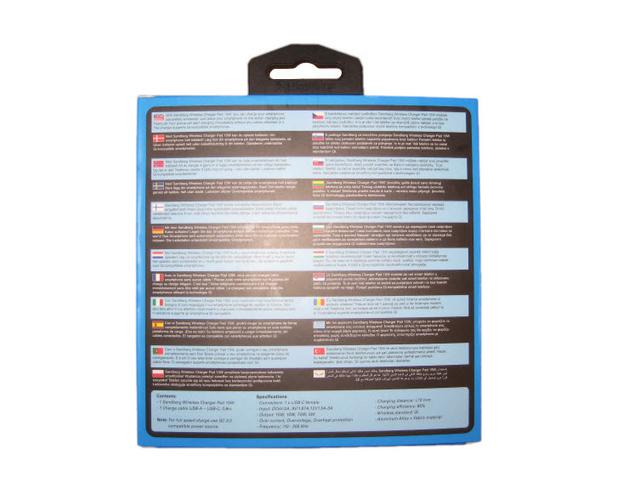-
Sandberg Wireless Charger Pad 15W
Introduction
One of the most common features being added to smartphones today is the ability to charge it without need of wires. Many of the flagship models released in the last few months come with wireless charging capabilities. There are actually two wireless charging standards for phones: Qi and PMA. Some phones support both, some one, most neither. Just because you have a device that's capable of charging wirelessly doesn't mean you have a wireless charger. Indeed, you'll have to purchase accessories like that separately. One such product is the Sandberg Wireless Charger Pad 15W, a unit we've spent some time with over the last few weeks.

The Sandberg Wireless Charger Pad 15W has the following specifications:

Packaging & Contents
The Wireless Charger Pad 15W come in a nice retail box. On the front there is a large photo of the unit. The overall design is eye-catching and definitely something that would be a nice looking gift.

Moving at the rear we find a few words about the product in 24 languages right over the bundle contents and the product specifications.

Inside the box you will find the charging cable, and a paper for BullGuard Internet Security 90 days-3 devices subscription.


A Closer Look
The dimensions are 82x82x9 mm and the weight is a bit over 100 grams. It is quite a slim unit means that it will sit under a monitor with your device on top with plenty of room to play with.

Its solid aluminum base has a traditional silver finish and has a finely woven fabric top in a sharp grey color. Even though there's no rubber found on top, I didn't have any issues with my smartphone sliding around while charging, even without a case. If you're worried that it might get ripped or damaged, well it makes sense to think so, but at the same time, it's unlikely as all you're setting on top of this charger is a smartphone.

There is a small, green LED on the front which pulses gently when charging and stays lit when your phone is fully charged. It's not too bright compared to some others, but you might want to make sure it faces away from you if you're placing it on your nightstand.

The back is built from a solid metal plate.

To keep the device stable on the flat surface Sandberg uses small adhesive rubber feet.

Performance
Before using it, let's find out a little about Qi works. A native implementation of wireless charging would be to have the pad generate a constantly changing magnetic field, which would then induce a current in any circuit within the field. But a metal case of the kind fitted to Samsung phones, for example, would act as such a circuit so all the power would go to creating eddy currents within the aluminium case. A magnetic metal such as nickel or iron is not required for this. Any conductor will do. So a native inductive mechanism is not good for this implementation. Instead, resonant inductive coupling is used. The magnetic field is varied continuously at a particular frequency resulting in very little effect on most nearby conductors, but which results in a resonance in an LC circuit (L is for inductance, C is for capacitance) tuned to the right frequency. That's what's built into Qi compatible phones. The magnetic fields go right through the case, and tickle the reception circuit at just the right frequency to maximise transfer of power. That means that it's safe to put other things on the charging pad. Unless they're tuned quite precisely to the right resonant frequency they'll receive effectively no transfer of power. In addition, the receiving device " the phone " can communicate back to the charging device its power requirements so it can control proceedings. One final thing: Qi is an active system. Unlike a regular wired charger, the unit won't charge a phone that is switched off. The pad needs to be acknowledged by the device it is charging before it'll do anything.

Well, the Sandberg Wireless Charger Pad 15W certainly seemed safe. I put various metallic objects on it and nothing heated up. Indeed, nothing triggered it to switch on, evidenced by the LED remaining off. Later I tried putting a paper clip underneath a phone. The phone charged and the paperclip remained unaffected, apart from warming up to the same temperature as the pad's surface and the back of the phone due to normal thermal conductance. So I figure it's pretty safe. I used a Samsung Galaxy S6 and a Samsung Galaxy S7 for this test. I did virtually all the testing with their side and rear protective cases on. The thickness at the back was in both cases around one millimetre. As for operation, it couldn't be any simpler. You plug the power pack into an outlet, plug the cable into the pad and then put the pad somewhere convenient. Then you can just put your phone on the pad whenever you're there. A couple of times it wasn't charging and I needed to adjust its position. It should be roughly centered on the pad. Both pad and phone can get a bit warm as the charging proceeds, but no more so that the phones usually do when charging in the conventional way. When you put the phone down the LED on the pad switches green and the phone's lock screen lights up. The phone's battery indicator changed status to charging.

So how long does it take to charge up a phone? You won't be surprised to hear that it's nowhere near as fast as today's modern fast charge wired systems. That said, it can proceed at a reasonable clip. The S7 took 1 hour 56 minutes and 14 seconds to charge from 50% to 100% with the case on. If the battery indicator is accurate and has a linear relationship to charge, that would suggest that it took just under 140 seconds for each per cent. Without a cover it took, from 69%, 66 mins and 40 seconds to charge to 100%. It was somewhat warmer at the end of this cycle. That time would suggest just under 130 seconds for each per cent. The theory suggests a closer proximity would increase efficiency which should translate to faster charging, but clearly there wasn't that much in it. Probably not enough, anyway, to justify removing the case for charging. The phones themselves offered forecasts of charging time which tended towards optimism. For example, at one point, when it was at 77% charged, the S6 said that it would be fully charged in 40 minutes. But after 37 minutes it had reached 94% charged and said that it still had 13 minutes to go.

Final Thoughts
Look, if you're worried about the amount of charge left in your phone's battery and you have twenty minutes before you have to jump in an Uber for the airport, plug your phone in. Plug it into the charger that came with it, using the cable with it, and take advantage of its fast charge capabilities to pour in as much juice as possible. But the rest of the time, it's just so much easier to place the phone on the pad and let it quietly do its stuff and never have to muck around with those damned Micro-B USB cables again. Having one of these in a home office or central location could be quite handy in a home full of phones with wireless charging capability. The neutral colors and design ensure it looks great in any environment. Keep in mind it doesn't come with a power adapter. It would be nice to see the inclusion, but due the fact that most people probably have spares around, it doesn't feel like an issue to me.

The Sandberg Wireless Charger Pad 15W is easy to use and definitely offers wireless charging for Qi-enabled devices that support it. The Sandberg Wireless Charger Pad 15W is well made. Its price ($45) reflects the quality. Sandberg does have a strong reputation and also includes a 5 years warranty which covers your device if something happens during regular intended use of the charging pad. Sure, there are cheaper options out there but if peace of mind is what you're after, the extra cost might be worth it for you.
Last edited by testman78; 09-03-2019 at 08:16 PM.
 Posting Permissions
Posting Permissions
- You may not post new threads
- You may not post replies
- You may not post attachments
- You may not edit your posts
-
Forum Rules



















 Reply With Quote
Reply With Quote

Bookmarks